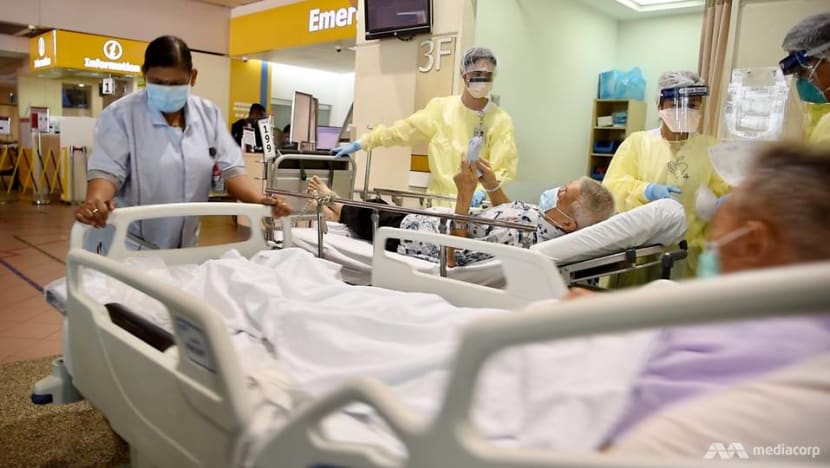Severe cases more important indicator of COVID-19 situation than infection growth rate, experts say

SINGAPORE: A fall in the infection growth rate to below 1 will show that the number of new weekly COVID-19 cases is falling, but the number of patients with severe infections is more important, experts said.
“If the weekly ratio goes below 1 for a sustained time, it means the epidemic is shrinking, at least in terms of the diagnosed cases,” said Dr Alex Cook, a disease modelling expert at the National University of Singapore (NUS).
But he cautioned that this could be due to the scaling back of contact tracing efforts and strictness of isolation and quarantine requirements.
“It’s important not to get too excited if the ratio falls below 1, unless the number of severe cases is also falling,” said Dr Cook, who is an associate professor and vice-dean of research at NUS' Saw Swee Hock School of Public Health.
“We should … not use the weekly ratio falling below 1 as an indicator that we can start relaxing measures, and instead should be looking at a broader set of metrics, in particular, the healthcare utilisation due to COVID.”
Co-chair of the COVID-19 task force Lawrence Wong said at a press conference last Saturday (Oct 23) that if the infection growth rate – the ratio of community cases in the past week over the week before – drops below 1, the Government will make some “calibrated” easing in restrictions.
This includes allowing members of the same household to dine-in at F&B outlets in a group of up to five people. Team sports can also resume in groups of up to five, and more activities in schools and institutions of higher learning will be allowed.
This is provided that the “hospital and ICU situation remains stable”, Mr Wong said.
As of Wednesday, the weekly infection growth rate in Singapore was 1.15.
IMPORTANCE OF SEVERE CASES
Infectious diseases specialist at Mount Elizabeth Novena Hospital Leong Hoe Nam similarly said that the number of cases needing intensive care and oxygen supplementation is an important indicator.
“To me, that's the most important measure because if everyone doesn't need to be hospitalised, then there's no burden on the healthcare system,” he said.
“These are the ones that are choking up the healthcare system,” said Dr Leong, explaining that a patient in the intensive care unit is usually hospitalised for a “couple of weeks” and needs a longer time to recover.
As of noon on Wednesday, there were 1,777 COVID-19 cases warded in hospital. This included 308 cases who required oxygen supplementation in the general ward, 76 who were unstable and under close monitoring in the ICU, and 66 critically ill and intubated in the ICU, according to the Ministry of Health (MOH).
The current overall ICU utilisation rate was 79.8 per cent, MOH said. It added that it was in the process of standing up more ICU beds.
Dr Leong cautioned that the weekly numbers may not account for cases that are not detected.
“There are probably pockets of infection all around the island,” he said.
Professor Dale Fisher said that the “major obstacle” to opening up more quickly is the threat to the healthcare system.
“This is what is most important and the weekly infection rate of the elderly and unvaccinated is an opportunity to look into the future needs for hospitalisation,” said the senior consultant at the National University Hospital's infectious diseases division.
He said that the infection growth rate, which “simply” compares the number of cases diagnosed with polymerase chain reaction (PCR) tests this week with the previous week, is a “rough guide”.
“The threat to the healthcare system is also impacted by who was infected such as their age and vaccine status,” he said.
THE INFECTION GROWTH RATE INDICATOR
Nevertheless, the experts said that the weekly ratio overcomes the problem of spikes or sharp declines on some days.
Dr Cook noted that there is usually a spike in cases on Tuesdays, mostly due to PCR results coming in for COVID-19 cases who waited until after the weekend to go to a clinic.
He added that the interpretation of the COVID-19 situation is not the same as with R, or reproduction rate, but that it is a “more straightforward and transparent” number to report, since there are multiple ways to calculate the R value and they are not “completely consistent”.
Prof Fisher, who is also chair of the World Health Organization’s Global Outbreak and Alert and Response Network, similarly said that the rate indicates whether the surge is flattening out and by looking over a week, removes day-to-day variation.
Dr Leong said that a “consistent trend” needs to be observed to show that the number of new cases is falling.
“You need to look at the decline, how rapid it is and whether it's plausible as well.”
The rate is a good “forecast” of the direction the country is headed in, he said, adding that the effect of an intervention typically takes four weeks to show in the number of cases in the ICU, “our biggest and most precious resource”.
WHEN CAN RESTRICTIONS BE EASED?
At some point, the current wave of infections will peak as a result of enough broad-based immunity in the population, Dr Cook said.
After the cases fall further from that peak, it may be possible to ease safe management measures, although he said that some restrictions may be relaxed sooner if the relative impact is minor. For instance, restrictions on outdoor sports “probably don't do much” to transmission rates.
Until then, the Government’s approach of extending the booster programme as more people become eligible for it, looking to acquire new therapeutics that can reduce the risk of severe infections and trying to persuade those who are not yet vaccinated to get their shot seems “reasonable”, he said.
“The only other change I would advocate for is to mandate vaccination, at least for the older age groups, which would roughly halve the impact of COVID on the healthcare system and stop us diverting beds from people needing surgery towards them,” Dr Cook said.
BOOKMARK THIS: Our comprehensive coverage of the COVID-19 pandemic and its developments
Download our app or subscribe to our Telegram channel for the latest updates on the coronavirus pandemic: https://cna.asia/telegram


















